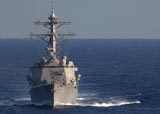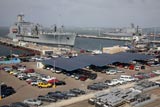
Assessing Energy Use, Navy-style
American Systems, Square D, and Weston Solutions vie for part of AMI business
- By L.K. Williams, EPonline
- Mar 13, 2009
 |
The USS Nitze (DDG 94) is one of several commands recognized by the Navy in October 2008 for energy conservation programs. |
Homeowners tend to turn the thermostat down after the high energy bill arrives. Comfort sometimes loses out to cost, which incidentally lowers consumption. The U.S. Department of Navy, which comprises more than 64 installations worldwide, requires the sharp skills of an entire accounting department to make its calculations.
But the Navy needs to know more. Federal agencies, including the military, must install advanced meters to measure their electrical energy use by Oct. 1, 2012, according to the U.S. Energy Policy Act of 2005. With this data, the government hopes to find ways to lower usage and costs. The Energy Independence and Security Act of 2007 adds gas, steam, and water to the mix of commodities that must be assessed. It also requires that time-of-use rate information be incorporated into the Advanced Metering Infrastructure (AMI) network architecture. While these measurements are being taken, the U.S. Department of Energy is developing standards for conservation.
Advanced or "smart" meters are solid state devices that have enough circuitry to provide wireless transmission and can send and receive data. Using smart meters, operators can change measuring frequency or sensitivity, for example. Household electromechanical "dumb" meters have no communication abilities.
B.J. Penn, assistant secretary of the Navy (Installations and Environment), seems to be interested in doing more. "I think we have standards imposed upon us, but I think these are goals and not targets." Penn, who was recalled to the Navy as a civilian in 2001, recognized wasteful behavior during his 26 years of service.
"When I was in Navy, I commanded one of the largest stations [Naval Base Coronado, Calif.] Our utility bill was $11 million a year 20 years ago. That was really a lot of money then, and we couldn't afford it," he said. "If we were able to reduce our expenses, we could keep the money we saved for other needs," he explained, adding that the incentive helped the station win an energy award.
"We have to be very aggressive about this," Penn said. "It's the right thing to do."
The Navy is predicting a 10 percent savings, about $100 million, in its energy costs after completing the AMI project, according to Navy AMI Project Manager Bill Anderson.
Anderson, who used to work with Pacific Gas & Electric Co. (PG&E), explained that an estimated 18,000 metering devices will be needed for the Navy and about 2,000 for the Marine Corps. Those meters will be put on buildings at installations and ships at pier. "The number is not interesting," Anderson said, noting that PG&E is deploying 9 million meters. "What's significant is that we are doing this on a global basis."
 |
In addition to its AMI project, the Department of the Navy is looking into renewable power such as sun energy. U.S. Navy photo, April 2008 |
Consider this: The Navy will deal with 100 different utility providers. Its facilities reach across time zones and in each of these, the Navy must consider unique requirements for its network design, including building density, topography, geography, and climate impacts. "We don't have the benefit of just tailoring the program to a homogenous region, but we still will strive to deliver the same functional requirements," Anderson said.
To get started, the Navy put out a bid for its AMI program in September 2008. American Systems, Inc. of Chantilly, Va.; Square D of Palatine, Ill.; and Weston Solutions of San Antonio, Texas, each were awarded the firm-fixed price, indefinite-delivery/indefinite-quantity multiple award contract. According to the Navy, the maximum dollar value for all three contracts is $250 million. The work involves the design, procurement, installation, testing, and sustainment of building-level advanced metering solutions.
"We're working with the appropriations that we have, outside of the stimulus package. We are programming the right amount of money so we can be done with our meters by 2012," explained Chris Tindal, the Navy's deputy director for Renewable Energy. "We really haven't had a need to seek additional funding."
Tindal explained that the Navy has refined its model and based it on consumption at each installation. The Navy wants to capture approximately 95% of the base consumption, so it is aiming to install electric meters on buildings with either 70 KW or 85 KVA or higher consumption. "We do not intend to put a meter on every building. We need to be prudent with the taxpayer dollar," he said.
The department runs a tight ship and expects the same of its contractors.
"When we looked at bidding this job for the Navy, we came at it with the perspective of a full approach -- we will integrate data from centers and draw conclusions about their usage across the globe to determine how they're doing with their energy use and where it's going," said Peter Smith, executive vice president of operations at American Systems, Inc.
Dan Vesey, Square D's national business development manager for the Department of Defense, said that his company has "gone beyond" just measuring energy and allocating costs by using "intelligent metering devices. One of the things that gives Square D an advantage is that we're a manufacturer and solution provider," he said.
Because of the intense competition, Vesey declined to say which intelligent meters his company would be using in the contract. However, he said Square D would connect Navy and Marine Corps utility flow meters to its intelligent electrical meters.
Weston Solutions, which has a 30-year history of working with the Department of Defense, also is looking to support the Navy's energy management goals. Michael Witt, Ph.D., Weston's program manager for the contract, said "We think we have the strongest team," adding that the firm has offices worldwide that can accommodate sites the Navy will be "wrestling with."
The Navy selected American Systems, Square D, and Weston Solutions for the
AMI contract, but these three must compete against each other for each task order. The companies are anticipating that new task orders will be put to bid this spring.
About the Author
L.K. Williams is the Environmental Group Editor of 1105 Media.